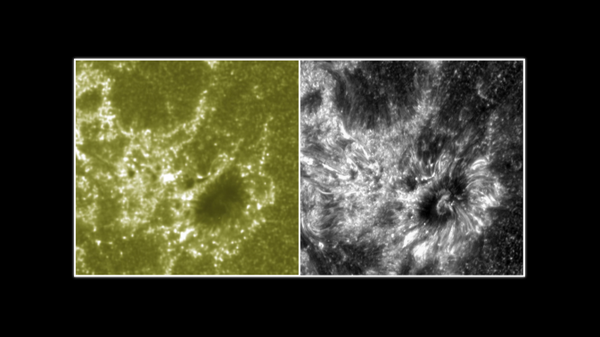WASHINGTON, July 25 (RIA Novosti) – NASA’s Interface Region Imaging Spectrograph (IRIS) spacecraft has captured its first images of a little-observed region of the sun’s atmosphere and scientists think the images, with unprecedented detail, will help unravel some of the enduring mysteries surrounding Earth’s closest star, the US space agency said Thursday.
The images were taken last week when the doors to IRIS’s telescope were opened and its lens was trained on the interface region of the sun’s atmosphere. (The video can be seen below.)
Scientists say that understanding the interface region, which is made up of the lowest parts of the sun’s atmosphere, the chromosphere and the transition region, is essential to understanding the sun’s secrets, in particular how heat is transferred from the surface of the sun to the upper level of the atmosphere, or the corona, where temperatures reach more than 1.8 million degrees Fahrenheit (1 million degrees Celsius), or 1,000 times hotter than on the surface.
“There are some real, deep mysteries as to how the sun works and especially how the corona is heated, and we’ve endeavored for many years to try to understand these phenomena,” John Grunsfeld, associate administrator of the Science Mission Directorate at NASA Headquarters in Washington, told a news conference.
But when the doors of IRIS’s telescope opened, “It was truly a grand opening of a new era of solar physics, to be able to understand this interface region, which is a crucial link in unraveling the mysteries of the sun,” he said.
The interface region has been little observed until now, but understanding it is key because it drives solar phenomena like the solar wind, which during extreme space weather can cause power outages on earth and disrupt GPS systems and satellite communications.
“With IRIS, we hope to observe the large explosions that affect our high-tech society such as flares and coronal mass ejections, and we are also focusing on what makes the sun’s atmosphere tick when it’s not undergoing such dramatic changes,” said Bart dePontieu, a lead scientist on the IRIS project, working out of Lockheed Martin’s Advanced Technology Center in California.
IRIS, which launched on June 27, uses its ultraviolet telescope and a spectrograph to observe the interface region “more clearly than ever before.”
The telescope provides images with 10-times greater resolution than what was previously available to NASA, while the spectrograph splits the sun’s light into its various wavelengths and measures how much of any given wavelength is present.
Some of IRIS’s first images showed thin, fiber-like structures that have never been seen before, which scientists say show contrasts in density and temperature that occur throughout the interface region, while other images showed spots that rapidly brighten and dim. To scientists, those spots indicate that energy is being transported and absorbed in the interface.
“There are some things in these images that we had expected but other things that are new to us,” said Alan Title, principal investigator on the IRIS project, adding that scientists have only just begun to analyze the images, which will take some time even with state-of-the-art 3-D modelling.
“We’ve taken some of the data we’ve seen and run numerical simulations – these take much longer to do than the sun takes to do them – and we’re beginning to get hints. But we’re not ready to make strong statements until we begin to understand what we’re seeing,” Title said.

